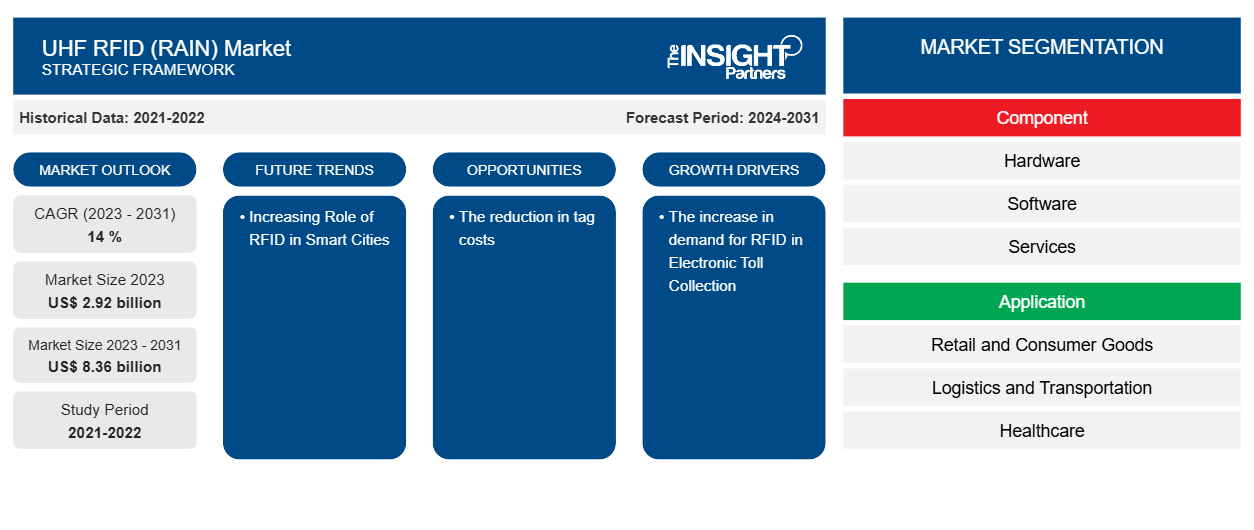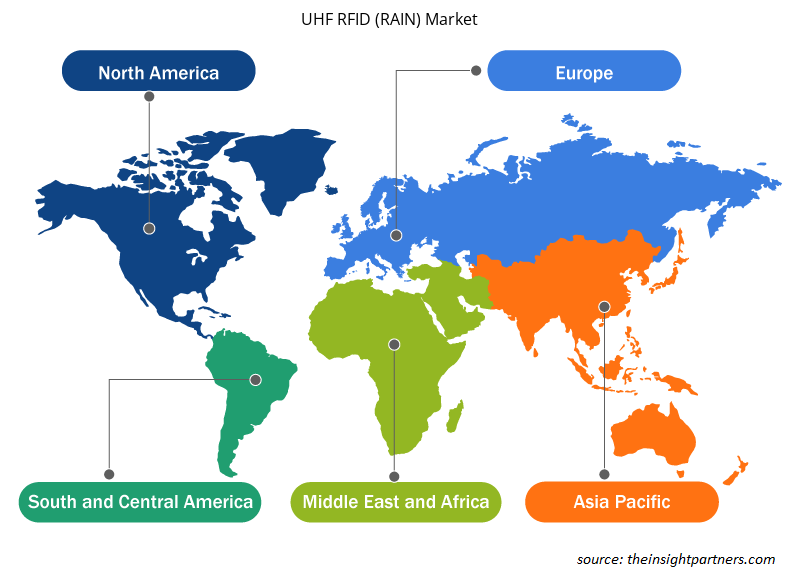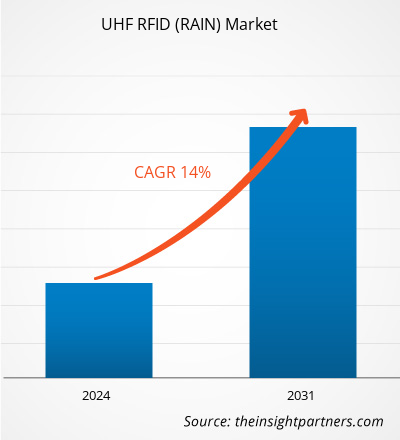Der Markt für UHF-RFID (RAIN) wird voraussichtlich bis 2031 ein Volumen von 14,07 Milliarden US-Dollar erreichen, ausgehend von 4,62 Milliarden US-Dollar im Jahr 2024. Für den Zeitraum 2025–2031 wird eine durchschnittliche jährliche Wachstumsrate (CAGR) von 17,9 % erwartet. Die zunehmende Verbreitung in der Automobilindustrie dürfte in den kommenden Jahren neue Trends auf den Markt bringen.
UHF RFID (RAIN) Marktanalyse
RAIN (UHF RFID) ist eine drahtlose Technologie, die es Unternehmen und Verbrauchern ermöglicht, alltägliche Produkte zu identifizieren, zu lokalisieren, zu verifizieren und mit ihnen zu interagieren, indem sie diese mit dem Internet verbinden. Das RAIN-Spektrum liegt im oberen Band (zwischen 860 und 960 MHz) des Ultrahochfrequenzbereichs der RFID-Technologie und entspricht bestimmten Standards und Protokollen. RAIN RFID ist eine passive, batterielose Technologie, die mit Ultrahochfrequenzen (UHF) arbeitet und Gegenstände aus Entfernungen von bis zu 15 Metern identifizieren kann. Sie kann bis zu 1.000 Gegenstände pro Sekunde erkennen, selbst ohne direkte Sichtverbindung. Die RAIN-Technologie verwaltet Daten, ergreift Maßnahmen und liest und beschreibt markierte Gegenstände über ein Lesegerät. Diese Fähigkeiten ermöglichen es Unternehmen und Kunden, jedes Objekt mit einem RAIN-Tag zu erkennen, zu finden, zu verifizieren und mit ihm zu interagieren. RAIN bietet umfassende Echtzeitdaten und Einblicke für Anwendungen wie Lieferkettenoptimierung, Anlagenverfolgung und Bestandsverwaltung.
UHF-RFID (RAIN) Marktübersicht
RAIN RFID wird in Märkten eingesetzt, um Waren effektiv zu identifizieren, zu lokalisieren und zu authentifizieren. Es zeichnet sich gegenüber anderen IoT-Technologien durch seine Verfügbarkeit, Erschwinglichkeit und Benutzerfreundlichkeit aus. Die Fähigkeit von RAIN RFID, die Sichtbarkeit zu erhöhen und präzise Daten zu liefern, macht es zu einem Wendepunkt im digitalen Zeitalter.
Passen Sie diesen Bericht Ihren Anforderungen an
Sie erhalten kostenlos Anpassungen an jedem Bericht, einschließlich Teilen dieses Berichts oder einer Analyse auf Länderebene, eines Excel-Datenpakets sowie tolle Angebote und Rabatte für Start-ups und Universitäten
UHF-RFID (RAIN)-Markt: Strategische Einblicke

-
Informieren Sie sich über die wichtigsten Markttrends in diesem Bericht.Dieses KOSTENLOSE Beispiel umfasst Datenanalysen, von Markttrends bis hin zu Schätzungen und Prognosen.
UHF RFID (RAIN) Markttreiber und Chancen
Steigende Akzeptanz von RFID-Technologien im Einzelhandel
Entwicklungen im Bereich der Bestandsverfolgungstechnologien und die Fokussierung auf Online-Marketing-Tools wie Facebook- und Google-Anzeigen treiben das Wachstum des Einzelhandels voran. Er zählt zu den etablierten Branchen in den USA, in denen Verbraucher gerne online einkaufen. Laut Angaben des Census Bureau des US-Handelsministeriums beliefen sich die E-Commerce-Umsätze im Einzelhandel in den USA im Jahr 2024 auf 1192,6 Milliarden US-Dollar, was einem Anstieg von 8,1 % gegenüber 2023 entspricht.
Im Einzelhandel wird RFID (Radio Frequency Identification) zur Kennzeichnung von Kleidung eingesetzt . Bekleidungsanbieter integrieren Digitalisierung und Big-Data-Analyse in RFID-Anwendungen. Die RFID-Technologie nutzt Funkwellen, um Daten von RFID-Tags an ein Lesegerät zu übertragen. So können Objekte anhand der empfangenen Daten identifiziert und ihre Standorte verfolgt werden. Unternehmen suchen nach kostengünstigen Lösungen, um ihre Betriebseffizienz zu steigern und ihre Gemeinkosten zu senken. Daten von Accenture zeigen, dass 93 % der nordamerikanischen Einzelhändler RFID in irgendeiner Form nutzen, um diese Ziele zu erreichen. Einzelhandelsriesen wie H&M, Lululemon, Zara und Nike nutzen UHF-RFID-Technologie für das Bestandsmanagement. Dies hilft ihnen, eine effektive Lieferkette aufrechtzuerhalten, gefälschte Artikel zu bekämpfen und Lagerbestände zu vermeiden. Walmart verpflichtete seine Bekleidungslieferanten 2020, ihre Produkte mit RFID-Etiketten zu versehen. 2022 wurde die Verpflichtung auf Spielzeug, Elektronik und andere Haushaltsartikel ausgeweitet. Das Mandat wurde 2023 und 2024 auf alle Bereiche von Automobilzubehör bis hin zu Sportartikeln ausgeweitet. Bis 2025 dürfte die Anforderung auch für die meisten anderen Produktkategorien gelten, die in Walmart-Filialen verkauft werden. Die Umsetzung solcher Initiativen im Einzelhandel treibt das Marktwachstum in diesem Segment voran. RFID) is adopted for digitalization and Big Data analytics in RFID applications. RFID technology utilizes radio waves to transmit data from RFID tags to a reader, enabling the identification of objects based on the received data and facilitating the tracking of their locations. Organizations are seeking affordable solutions that enable them to increase operational efficiencies and reduce overhead costs. Data from Accenture shows that 93% of North American retailers are using RFID in some capacity to achieve these goals. Retail sector giants, such as H&M, Lululemon, Zara, and Nike, use UHF RFID technology for inventory management, helping them maintain an effective supply chain, combat counterfeit items, and prevent out-of-stock situations. Walmart mandated its clothing suppliers to attach RFID labels on their products in 2020. In 2022, the mandate was extended to cover toys, electronics, and other home items. The mandate expanded to cover everything from automotive supply to sporting products in 2023 and 2024. By 2025, the majority of other product categories that are sold in Walmart stores are expected to be covered by the requirement. The implementation of such initiatives in the retail sector drives the market growth in the segment.
Einsatz der UHF-RFID-Technologie in IoT-Geräten
Die Einführung intelligenter Geräte und staatliche Investitionen – insbesondere in Ländern wie Japan, Singapur, China und Australien – in Forschung, Entwicklung und Implementierung des Internets der Dinge (IoT) in Branchen wie Fertigung, Versorgung und Einzelhandel treiben das IoT-Wachstum voran. IoT-Anwendungen erfordern eine Datenverbindung zwischen der physischen und der digitalen Welt, und UHF-RFID-Technologie dient dazu, diese Bereiche zu überbrücken. Mit dem IoT-Boom werden die meisten vernetzten Objekte drahtlos über passive UHF-RFID-Technologie verbunden. Diese ermöglicht es passiven Objekten, wichtige Daten zu übermitteln, die zur Identifizierung dieser Objekte mit genauen Orts- und Zeitangaben genutzt werden können. Die Technologie verleiht dem IoT-Ökosystem Intelligenz und vereinfacht neue Anwendungen für vernetzte Ressourcen.
Im Juli 2023 veröffentlichte Impinj, Inc. die RAIN-RFID-Tag-Chips der Impinj M800-Serie zur Unterstützung von IoT-Implementierungen und zur Verbesserung der Artikelkonnektivität für Unternehmen. Diese Chips verbessern Lesbarkeit, Zuverlässigkeit und Herstellbarkeit und steigern Geschwindigkeit, Reichweite und Zuverlässigkeit von RAIN-RFID-Systemen bei der Verfolgung und Sicherung vernetzter Artikel. Diese Integration hilft Unternehmen, fundierte Entscheidungen auf Basis präziser Informationen zu treffen. Durch die Verbindung von RFID-Tags mit dem Internet können Unternehmen Daten über Artikelstandort, Nutzungsmuster und Umgebungsbedingungen sammeln, die für prädiktive Analysen genutzt werden können . Daher wird erwartet, dass die Integration der UHF-RFID-Technologie in IoT-Geräte zukünftige Wachstumschancen im Markt schafft.
UHF RFID (RAIN) Marktbericht Segmentierungsanalyse
Wichtige Segmente, die zur Ableitung der UHF-RFID (RAIN) -Marktanalyse beigetragen haben, sind Komponente und Anwendung.
- Basierend auf den Komponenten ist der globale UHF-RFID (RAIN)-Markt in Hardware, Software und Dienstleistungen segmentiert. Das Hardwaresegment hielt im Jahr 2024 den größten Anteil am UHF-RFID (RAIN)-Markt.
- Der UHF-RFID-Markt (RAIN) ist nach Anwendung in die Bereiche Einzelhandel und Konsumgüter, Logistik und Transport, Gesundheitswesen, Fertigung, Automobilindustrie, Luft- und Raumfahrt und Verteidigung sowie weitere segmentiert. Das Segment Einzelhandel und Handelswaren hatte im Jahr 2024 den größten Anteil am UHF-RFID-Markt (RAIN).
UHF RFID (RAIN) Marktanteilsanalyse nach Geografie
Der geografische Umfang des UHF-RFID (RAIN)-Marktberichts ist hauptsächlich in fünf Regionen unterteilt: Nordamerika, Asien-Pazifik, Europa, Naher Osten und Afrika sowie Süd- und Mittelamerika.
Nordamerika hatte 2024 einen bedeutenden Marktanteil. Die USA, Kanada und Mexiko gehören zu den wichtigsten Ländern Nordamerikas. Laut der Federal Communications Commission (FCC) arbeiten die RFID-UHF-Bänder in der Region über das Spektrum von 902–928 MHz, wobei die Lesegeräte über den größten Teil dieser Bandbreite mit maximaler Leistung senden. In Nordamerika wird die RFID-Technologie im Einzelhandel eingesetzt, um Daten von an Objekten angebrachten Tags mithilfe eines drahtlosen Scansystems zu übertragen; dieser Aufbau dient hauptsächlich der automatischen Identifizierung und Verfolgung. Einfaches Tracking, niedrige Kosten und effektives Bestandsmanagement treiben die Einführung dieser Technologie im nordamerikanischen Einzelhandel voran. Laut der International Trade Administration (ITA) gab es im Jahr 2022 in Kanada über 27 Millionen E-Commerce-Nutzer, was 75 % der kanadischen Bevölkerung entspricht. Diese Zahl soll bis 2025 auf 77,6 % steigen.
Der wachsende Einzelhandel in Nordamerika steigert die Nachfrage nach UHF-RFID-Technologie zur effizienten Bestandsverfolgung. Daher sind Unternehmen stark daran interessiert, diese Technologie zu entwickeln, um den wachsenden Anforderungen des Einzelhandels gerecht zu werden. Im Mai 2022 brachte die Avery Dennison Corporation zwei Ergänzungen zu ihrem wachsenden Dual-Frequency (DF)-Sortiment an RFID-Inlays auf den Markt. Diese bieten kombinierte NFC (HF)- und RAIN RFID (UHF)-Funktionalität für die Artikelkennzeichnung auf kleinem, kostengünstigem Wege. Die neuen Inlays und Tags AD Medio Web DF EM4425 und AD Web DF EM4425 V12 sind für Markenschutz, Lieferkettenmanagement und Kundenbindung konzipiert. AD Medio Web DF wurde für Anwendungen in der Pharma- und Gesundheitsbranche entwickelt, während AD Web DF sich auf Anwendungsfälle im Einzelhandel konzentriert. Basierend auf Avery Dennisons erfolgreicher AD Web RAIN RFID-Produktlinie kombinieren beide Produkte hervorragende Leistung mit einer einzigartigen Dual-Frequency-Fähigkeit. Durch den Betrieb in den HF- und UHF-RFID-Frequenzbereichen bieten sie erhebliche Kostenvorteile im Vergleich zur Verwendung zweier separater Single-Frequency-Inlays.
Regionale Einblicke in den UHF-RFID (RAIN)-Markt
Die Analysten von Insight Partners haben die regionalen Trends und Faktoren, die den UHF-RFID-(RAIN)-Markt im Prognosezeitraum beeinflussen, ausführlich erläutert. Dieser Abschnitt behandelt außerdem die Marktsegmente und die geografische Lage von UHF-RFID-(RAIN)-Markt in Nordamerika, Europa, Asien-Pazifik, dem Nahen Osten und Afrika sowie Süd- und Mittelamerika.

- Erhalten Sie regionale Daten zum UHF-RFID-Markt (RAIN)
Umfang des UHF-RFID (RAIN)-Marktberichts
| Berichtsattribut | Details |
|---|---|
| Marktgröße im Jahr 2024 | 4,62 Milliarden US-Dollar |
| Marktgröße bis 2031 | 14,07 Milliarden US-Dollar |
| Globale CAGR (2025 – 2031) | 17,9 % |
| Historische Daten | 2021-2023 |
| Prognosezeitraum | 2025–2031 |
| Abgedeckte Segmente |
Nach Komponente
|
| Abgedeckte Regionen und Länder |
Nordamerika
|
| Marktführer und wichtige Unternehmensprofile |
|
Marktteilnehmerdichte für UHF-RFID (RAIN): Auswirkungen auf die Geschäftsdynamik
Der UHF-RFID-Markt (RAIN) wächst rasant. Die steigende Endverbrauchernachfrage ist auf Faktoren wie veränderte Verbraucherpräferenzen, technologische Fortschritte und ein stärkeres Bewusstsein für die Produktvorteile zurückzuführen. Mit der steigenden Nachfrage erweitern Unternehmen ihr Angebot, entwickeln Innovationen, um den Verbraucherbedürfnissen gerecht zu werden, und nutzen neue Trends, was das Marktwachstum weiter ankurbelt.
Die Marktteilnehmerdichte beschreibt die Verteilung der in einem bestimmten Markt oder einer bestimmten Branche tätigen Unternehmen. Sie gibt an, wie viele Wettbewerber (Marktteilnehmer) in einem bestimmten Marktraum im Verhältnis zu dessen Größe oder Gesamtmarktwert präsent sind.
Die wichtigsten Unternehmen auf dem UHF-RFID-Markt (RAIN) sind:
- Caen RFID SRL
- Convergence Systems Limited
- Impinj, Inc.
- Invengo Technology PTE. LTD.
- Jadak
- Lowry Solutions Inc.
Haftungsausschluss : Die oben aufgeführten Unternehmen sind nicht in einer bestimmten Reihenfolge aufgeführt.

- Überblick über die wichtigsten Akteure auf dem UHF-RFID-(RAIN)-Markt
UHF RFID (RAIN) Marktnachrichten und aktuelle Entwicklungen
Der UHF-RFID-Markt (RAIN) wird durch die Erhebung qualitativer und quantitativer Daten aus Primär- und Sekundärforschung bewertet, die wichtige Unternehmenspublikationen, Verbandsdaten und Datenbanken umfasst. Nachfolgend sind einige Entwicklungen im UHF-RFID-Markt (RAIN) aufgeführt:
- Avery Dennison hat die Erweiterung seines AD Pure-Sortiments angekündigt, einem Portfolio an Inlays und Tags, die vollständig PET-plastikfrei sind. AD Pure Inlays und Tags werden nachhaltig mit innovativer Antennenherstellungstechnologie hergestellt. Antenne und Chips werden direkt auf Papier aufgebracht, wodurch das Sortiment 100 % plastikfrei ist. (Quelle: Avery Dennison, Pressemitteilung, April 2024)
- Checkpoint Systems hat Warnsysteme erworben, um sein Lösungsportfolio zur Bekämpfung organisierter Einzelhandelskriminalität mit Schwerpunkt auf Metall- und Magneterkennung im Einzelhandel zu stärken. (Quelle: Checkpoint Systems, Pressemitteilung, April 2023)
UHF RFID (RAIN) Marktbericht – Abdeckung und Ergebnisse
Der Bericht „UHF RFID (RAIN) Marktgröße und Prognose (2021–2031)“ bietet eine detaillierte Analyse des Marktes, die die folgenden Bereiche abdeckt:
- UHF RFID (RAIN) Marktgröße und Prognose auf globaler, regionaler und Länderebene für alle wichtigen Marktsegmente, die im Rahmen des Berichts abgedeckt sind
- UHF RFID (RAIN) Markttrends sowie Marktdynamiken wie Treiber, Einschränkungen und wichtige Chancen
- Detaillierte PEST- und SWOT-Analyse
- UHF-RFID (RAIN)-Marktanalyse mit wichtigen Markttrends, globalen und regionalen Rahmenbedingungen, wichtigen Akteuren, Vorschriften und aktuellen Marktentwicklungen
- Branchenlandschaft und Wettbewerbsanalyse mit Marktkonzentration, Heatmap-Analyse, prominenten Akteuren und jüngsten Entwicklungen für den UHF-RFID (RAIN)-Markt
- Detaillierte Firmenprofile
- Historische Analyse (2 Jahre), Basisjahr, Prognose (7 Jahre) mit CAGR
- PEST- und SWOT-Analyse
- Marktgröße Wert/Volumen – Global, Regional, Land
- Branchen- und Wettbewerbslandschaft
- Excel-Datensatz
Aktuelle Berichte
Erfahrungsberichte
Grund zum Kauf
- Fundierte Entscheidungsfindung
- Marktdynamik verstehen
- Wettbewerbsanalyse
- Kundeneinblicke
- Marktprognosen
- Risikominimierung
- Strategische Planung
- Investitionsbegründung
- Identifizierung neuer Märkte
- Verbesserung von Marketingstrategien
- Steigerung der Betriebseffizienz
- Anpassung an regulatorische Trends






















 Kostenlose Probe anfordern für - UHF-RFID (RAIN)-Markt
Kostenlose Probe anfordern für - UHF-RFID (RAIN)-Markt